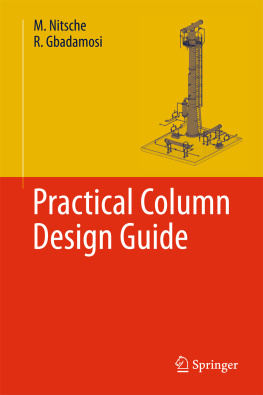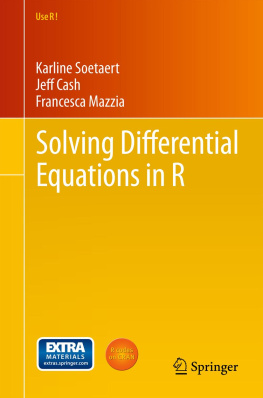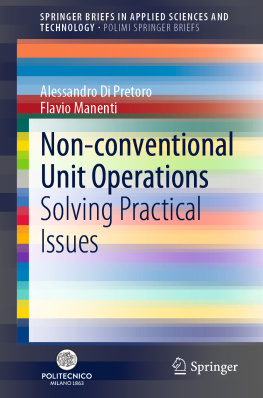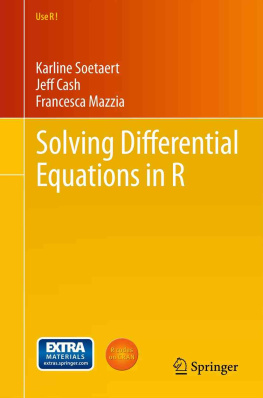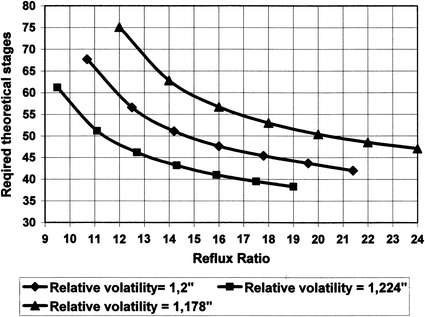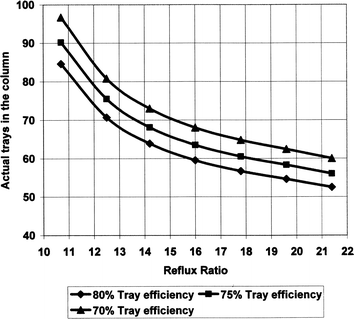1.1 Planning Information
The basis for each plan of a distillation or absorption plant is the determination of the required number of trays and the required reflux ratio for fractionating, the required absorption fluid flow rate for absorption or the stripping gas flow rate.
These calculations are mostly performed with computers. However, care must be taken in the unchecked acceptance of a computer generated result.
There are several measured physical properties and measured vapourliquid equilibrium data showing comparably deviating results. Small inaccuracies in vapour pressure or different equilibrium data or the choice of the calculation model for the equilibrium can result in substantial deviations in the design.
Figure shows how the required number of trays and the reflux ratio change if the equilibrium is better or worse, by the order of 0.2%, than that assumed. Since the number of trays in an existing plant cannot be increased distillation has to be achieved with a higher reflux ratio, for instance, with R = 20 instead of R = 15, if the vapourliquid equilibrium is worse.
Fig. 1.1
Required theoretical trays as a function of the reflux ratio for different relative volatilities
Figure shows the influence of tray efficiency on the required reflux ratio.
Fig. 1.2
Actual trays required for different tray efficiencies
If the tray efficiency is poor the reflux ratio has to be increased, for instance from R = 16 to R = 18.5 for 60 trays, if the tray efficiency is only 75% rather than 80%.
The additional vapour and liquid loadings at a higher reflux ratio, due to poorer vapourliquid equilibrium or poorer tray efficiency, must be considered while designing column internals. Sufficient reserve capacities must be available in the column.
Reboilers and condensers must be dimensioned for higher heat loads at higher reflux ratios.
Rules for a trouble-free operation
The flow chart in Fig. shows the required accessories for a distillation plant. Each individual piece of equipment, each pump, each control valve, each vessel and each component of piping must be accurately designed and its control system must function properly:
Fig. 1.3
Fractionation column with feed and product vessels
A sufficient feed height must be present for top condensers in order to avoid reflux variations [].
Where there is condensation in tubes, for instance in air coolers, the maximal vapour flow capacity of the condenser must be determined with an adiabatic flow factor [].
The outlet pipe from the condenser to the accumulator should be self-venting [].
Vibrations in the U-tube formed by the column and thermosiphon reboiler can be a problem. The frequency of the vibrations depend on the tube length. These vibrations can be removed by applying a greater pressure drop, for instance by using a larger circulation, or an orifice plate, in the downcomer.
When drawing boiling liquids as side streams from the column, a sufficient liquid height over the nozzle must be provided in order to avoid flash evaporation in the withdrawal pipe [].
Measurement nozzles for temperature, pressure and level must be provided.
The piping with flow meters and control valves must be accessible in the steel framework for maintenance purposes.
Depending on the mass and energy balance and the available utilities, for instance 12-bar of steam and cooling water at 25 C, the reboilers, condensers and heat exchangers used for heating the feed and cooling the distillate and bottoms streams must be appropriately dimensioned [].
When using the pumps the required Net Positive Suction Head (NPSH) value must be kept in order to avoid cavitation [].
In practice the columns are installed on 3-m foundations in order to provide sufficient liquid height.
If the boiling point is higher than the temperature of the given heating medium the vacuum distillation has to be adopted.
In order to decide on the dimensions of the vacuum pump the required suction pressure and the required suction capacity is needed []. There should be a minimum pressure drop in the vacuum piping.
The choice of the column internals should be determined using the allowable pressure loss and the available construction height, for instance in a production hall.
Demisters should be used in order to minimize the loss of valuable materials and to protect the vacuum pumps and compressors.
When deciding upon the dimensions of the piping for the product and utility streams, high-pressure losses or cavitation on bottlenecks should be avoided [].
The control valves must be designed for a functional working pressure drop [].
If sharp reduction occurs in valves which are designed too large, choked flow with cavitation may occur in the valve.
Construction notes
The columns must be calculated based on the pressure or vacuum and wind loads. The columns should not sway at high wind velocities.
In construction, consideration must be given to how internals can be installed into the column (manways) and what type of support is necessary in the column.
The support rings must have tight tolerances in order to allow an even installation of the trays or liquid distributors.
The nozzles for the evaporator, condenser, feed and side streams or side strippers must be properly arranged.
Sufficient flexibility must be provided for thermal expansion of hot piping in order to avoid large thermal stresses and protect the equipment and pump nozzles. Leakages must be avoided especially in the vacuum columns.
In order to avoid heat loss, and to provide surface protection, hot surfaces are appropriately insulated, mostly with mineral wool mats [].
What basic data are required for the design?
Flow rates with physical properties and equilibrium data, compositions, temperatures and pressures.
Heating and cooling medium along with temperatures and pressures: steam, organic heat transfer media, cooling water, cold water, and cooling brine.
Required materials: steel, stainless steel, monel, plastic, and graphite.
1.2 Mass Balance for the Separation Task
The starting point for every separation calculation is a mass balance with the required component distributions.
Example 1.2.1: Mass balance for a four-component mixture

